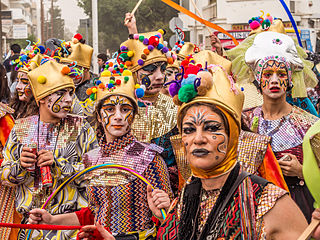
Carnival is a festive season that occurs during the Christian liturgical period of Shrovetide, the three days before Lent. consisting of Quinquagesima or Shrove Sunday, Shrove Monday, and Shrove Tuesday or Mardi Gras.

Rex is a New Orleans Carnival Krewe which stages one of the city's most celebrated parades on Mardi Gras Day. Rex is Latin for "King", and Rex reigns as "The King of Carnival".

Batik is an Indonesian technique of wax-resist dyeing applied to the whole cloth. This technique originated from the island of Java, Indonesia. Batik is made either by drawing dots and lines of wax with a spouted tool called a canting, or by printing the wax with a copper stamp called a cap. The applied wax resists dyes and therefore allows the artisan to colour selectively by soaking the cloth in one colour, removing the wax with boiling water, and repeating if multiple colours are desired.

The holiday of Mardi Gras is celebrated in southern Louisiana, including the city of New Orleans. Celebrations are concentrated for about two weeks before and through Shrove Tuesday, the day before Ash Wednesday. Mardi Gras is French for Fat Tuesday, the season is known as Carnival and begins on 12th Night, January 6th, and extends until midnight before Ash Wednesday. Club, or Krewe, balls start soon after, though most are extremely private, with their Kings and Queens coming from wealthy old families and their courts consisting of the season's debutantes. Most of the high society Krewes do not stage parades. As Fat Tuesday gets nearer, the parades start in earnest. Usually there is one major parade each day ; many days have several large parades. The largest and most elaborate parades take place the last five days of the Mardi Gras season. In the final week, many events occur throughout New Orleans and surrounding communities, including parades and balls.

Surakarta, known colloquially as Solo, is a major city in Central Java, Indonesia. The 46.72 km2 city adjoins Karanganyar Regency and Boyolali Regency to the north, Karanganyar Regency and Sukoharjo Regency to the east and west, and Sukoharjo Regency to the south. On the eastern side of Solo lies Solo River. Its metropolitan area, consisting of Surakarta City and the surrounding six regencies, was home to 6,837,753 inhabitants according to the official estimates for mid 2023, 526,870 of whom reside in the city proper.

The culture of Indonesia has been shaped by long interaction between original indigenous customs and multiple foreign influences. Indonesia is centrally-located along ancient trading routes between the Far East, South Asia and the Middle East, resulting in many cultural practices being strongly influenced by a multitude of religions, including Buddhism, Christianity, Confucianism, Hinduism, and Islam, all strong in the major trading cities. The result is a complex cultural mixture, often different from the original indigenous cultures.

The carnival in Colombia was introduced by the Spaniards. The Colombian carnival has incorporated elements from European culture, and has managed to syncretise, or re-interpret, traditions that belonged to the African and Amerindian cultures of Colombia. There is documentary evidence that the carnival existed in Colombia in the 17th century and had already caused concern to the colonial authorities, who censored the celebrations, especially in the main centers of power such as Cartagena, Bogotá and Popayán. The carnival, therefore, continued its evolution and re-interpretation in the small and at that time unimportant towns where celebrations did not offend the ruling elites. The result was the uninterrupted celebration of carnival festivals in Barranquilla, and other villages along the lower Magdalena River in northern Colombia, and in Pasto, Nariño in the south of the country. In modern times, there have been attempts to introduce the carnival in the capital, Bogotá, in the early 20th century, but it has always failed to gain the approval of authorities. The Bogotá Carnival has had to wait until the 21st century to be resurrected, this time, by the authorities of the city. Colombia is recognized by its large variety of festivals, carnivals and fairs. Most towns have their own, ranging from those celebrating coffee to the ones held in honor of the town's Saint feast. The common characteristics of the festivals are the nomination of a beauty Queen and the setting up of public dance floor.

The Carnival of Basel is the biggest carnival in Switzerland and it is the main Protestant carnival in the world. Basler Fasnacht takes place annually between February and March in Basel. It has been listed as one of the top fifty local festivities in Europe.

Wayang wong, also known as wayang orang, is a type of classical Javanese and Balinese dance theatrical performance with themes taken from episodes of the Ramayāna or Mahabharāta. Performances are stylised, reflecting Javanese court culture:
Wayang wong dance drama in the central Javanese Kraton of Yogyakarta represents the epitome of Javanese aesthetic unity. It is total theatre involving dance, drama, music, visual arts, language, and literature. A highly cultured sense of formality permeates every aspect of its presentation.

Nyi Roro Kidul is a supernatural being in Indonesian folklore. She is the Queen of the Southern Sea in Sundanese and Javanese mythology.

The Antiguan Carnival is a celebration of the emancipation of slavery in the country held annually from the end of July to the first Tuesday in August. The most important day is that of the j'ouvert, in which brass and steel bands perform for much of the island's population. Barbuda's Carnival, held in June, is known as Caribana. The Antiguan and Barbudan Carnivals replaced the Old Time Christmas Festival in 1957, with hopes of inspiring tourism in Antigua and Barbuda. Some elements of the Christmas Festival remain in the modern Carnival celebrations.
Batabano is the name of the Caribbean Carnival held in the Cayman Islands. The festival takes place annually during the first week of May in George Town. Batabano is a time for people of all different descents to gather with a common interest and celebrate community spirit. The Cayman Islands are home to over 100 different nationalities, all brought together and embraced by the festival. It is a cultural celebration filled with music, dance, and elaborate costumes that reflect the landscapes, heritage, and culture. International interest is growing in the Batabano celebrations, despite only having existed for about 30 years.

Mardi Gras is the annual Carnival celebration in Mobile, Alabama. It is the oldest official Carnival celebration in the United States, started by Frenchman Nicholas Langlois in 1703 when Mobile was the capital of Louisiana. Although today New Orleans and South Louisiana celebrations are much more widely known for all the current traditions such as masked balls, parades, floats and throws were first created there. From Mobile being the first capital of French Louisiana (1702), the festival began as a French Catholic tradition. Mardi Gras has now evolved into a mainstream multi-week celebration across the spectrum of cultures, becoming school holidays for the final Monday and Tuesday, regardless of religious affiliation.

The Carnival in the Dominican Republic is a Dominican celebration that takes place throughout February, and sometimes during Holy Week in March. Dominican Carnival is celebrated in most cities and towns in the main streets. The carnival season in the Dominican Republic kicks off with a carnival gala held indoors in Santiago de los Caballeros, as opposed to every other carnival event held outdoors throughout the month of February. Among its main characteristics are its flashy costumes and loud music. The one held in La Vega, which is one of the biggest in the country, and the national parade in Santo Domingo, were the first Carnivals held in the Americas.

Brigadier General Ignatius Slamet Rijadi was an Indonesian soldier.
Carnival in Mexico is celebrated by about 225 communities in various ways, with the largest and best known modern celebrations occurring in Mazatlán and the city of Veracruz.
Cokorda Istri Krisnanda Widani is an Indonesian Ministry of Tourism and Creative Economy Ambassador, National Narcotics Board of the Republic of Indonesia Ambassador, Balinese dancer, model, beauty pageant titleholder who was crowned Puteri Indonesia Pariwisata 2013 and represented Indonesia for the first time at the Miss Supranational 2013 beauty pageant, where she won as the 3rd Runner-up at the event.

Jember Fashion Carnaval or JFC is an annual carnival held in the East Java city of Jember. Officially it is written as Jember Fashion Carnaval; the word carnival here is officially spelled as carnaval, probably a confusion with Indonesian spelling karnaval, or an influence of the Dutch spelling carnaval. Jember Fashion Carnival has no relation with the Christian pre-Lenten festival, but more of a festivities in general, roughly following the Brazilian style, with procession of dancers in extravagant costumes, with emphasis on the traditional Indonesian motif.

The Limassol Carnival is an annual European carnival event held in Limassol, Cyprus. The main parade is held 12 days before the start of Lent, on the Sunday before Ash Monday, 50 days before Orthodox Easter. The festival is a colourful 10-day event of people eating, singing, satire, games, wearing costumes, and attending parties. The festival culminates with a large parade, which includes an array of floats traversing the city.

Batara Kresna Railbus is a railbus service in Central Java, Indonesia that operates between Purwosari Station in Surakarta and Wonogiri Station in Wonogiri Regency. It is operated by PT Kereta Api Indonesia (KAI) and is a cooperation project between the Surakarta city government and KAI, when the city was led by Joko Widodo. The service is the one of a few railbus service in Indonesia besides Lembah Anai railbus in West Sumatra and former Kertalaya railbus in South Sumatra.



















